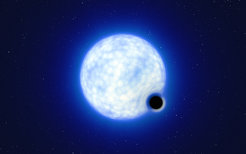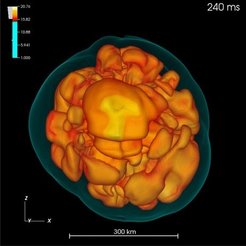Black-hole binary tests supernova theory
Observations of a newly discovered binary star system combined with advanced models of stellar collapse have provided key insights into the formation of stellar mass black holes. A team of international researchers at the Max Planck Institute for Astrophysics and the Niels Bohr Institute (NBI), University of Copenhagen, conclude that massive black holes can form without a bright supernova explosion. The energy from the collapse is carried away mainly by lightweight neutrino particles with only small asymmetry, leading to a small natal kick for the black hole.

For decades, we have known about the existence of binary star systems in the Milky Way, where one of the stars is a black hole. “The discovery of black-hole binary VFTS 243 in our neighbouring Large Magellanic Cloud was extraordinary, and the system itself is remarkable,” says Alejandro Vigna-Gómez, who was a postdoctoral researcher at NBI when the detection of VFTS 243 was announced, and is now based at the Max Planck Institute for Astrophysics (MPA). The binary system consists of a star with 25 times the mass of the Sun and a companion black hole 10 times the mass of the Sun.
Supernova Explosions

Stars that are several times more massive than the Sun end their lives in powerful and luminous explosions known as supernovae. The collapse of the dense metal core of the massive star releases a large amount of energy, mostly in neutrinos, while the outer layers of the star are expelled into outer space. This material can amount to many times the mass of the Sun and is ejected with velocities of hundreds to thousands of kilometres per second, leading to large-scale asymmetries of the ejected matter that we also observe in the remnants of the explosions.
These asymmetries and mass ejecta directly affect the very dense remnant at the core, the newly formed neutron star, which experiences a recoil – a natal kick – that can abruptly change its velocity. There is plenty of evidence of these natal kicks for neutron stars, as we observe them moving at large speeds throughout the Milky Way. However, for the most massive compact objects known, black holes, these natal kicks are not well understood. Such stellar black holes form in the collapse of massive stars, in particular when the explosion does not succeed and the in-falling matter collapses onto itself.
The recent discovery of “disappearing” stars suggests that a large fraction of collapsing massive stars form black holes without any explosion, which unlike the bright supernovae we cannot observe. However, it is unclear how much mass these stars lose during black hole formation, or how large their natal kicks are. If the massive star directly collapses into a black hole, no baryonic matter is ejected, and energy is predominantly lost via neutrinos. “VFTS 243 has allowed us to test this scenario,” says Vigna-Gómez.
Collapse scenario

The team explored the complete collapse scenario for the black hole binary VFTS 243, where a star ten times more massive than the Sun in its final stage had concluded its life-cycle via an implosion. With state-of-the-art models of stellar collapse developed at MPA, they calculated the effects on the orbit of a binary star system during the black hole formation. In the complete collapse scenario, the huge gravitational binding energy released during black hole formation is exclusively carried away by the weakly interacting, neutral, and lightweight particles known as neutrinos.
“Probing the physical processes that take place in the deepest interior of collapsing stars is extremely difficult and only possible under special circumstances,” says H.-Thomas Janka, supernova theorist at MPA. “The black hole observed in the binary system VFTS 243 is such a special case,” adds Daniel Kresse, postdoctoral researcher in Janka’s group. “It allowed us to conclude, for the first time, that neutrinos are emitted nearly equally in all directions when the massive progenitor collapsed to form the black hole.”
“Our study is a prime example of the synergy between theory and observations,” concludes Vigna Gómez. “Combining advanced numerical models of stellar collapse with the principles of supernovae in binary star systems, allowed us to obtain crucial insights into the complete collapse scenario, in particular proving that massive black holes can form without an explosion.”














